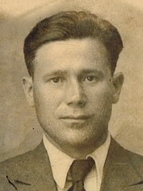
Lazar Mikhlin, 36 years old in 1939, Klimovichi
|
Lazar’s father, Moishe Mikhlin (1883-1915) was the youngest son of cantor Abram
Mikhlin and maternal uncle of Ruvim.
The only definite memory of his father was his return home as a disabled veteran
after serving in the Imperial Russian Army during World War I. Moishe had
survived a gas attack by the Germans, but as he was injured, he was discharged
and sent home.
He died shortly thereafter. Moishe was married off early at age 18 to Pesya Katz
who was from a large family (she was Ruvim’s aunt, the sister of his father
Isaac) in a small village about 30 km from Petrovichi called Kholmi ("Hills", in Russian).
The marriage was arranged by Moishe’s older brother, Iekhiel-Mikhel Mikhlin
(1873-1949), who was in business selling meat in an open market with the Katz
family.
The newly married couple moved to settle down in Kholmi. Unfortunately, there
wasn’t anywhere to live in Kholmi.
|
So Pesya’s parents bought the couple a hut, which had previously been an
ordinary village bathhouse. In this hut, Pesya gave birth to 5 children, and
Lazar was the second born.
There is not any additional saved information about Moishe Mikhlin, Lazar’s
father. He died early at age 30 and his family was left without a breadwinner
while some children were still very young.
How they lived, says Ruvim Katz, you could only wish upon your enemies.
They lived in terrible poverty without even flour to bake bread. For this
reason, Lazar’s family resorted to buying cheap bread remnants from the village
panhandlers.
Given their bearded appearance, the panhandlers were called “elders.” Being
constantly hungry, Pesya’s children were running to Ruvim’s family home and they
were fed there.
At age 8, Lazar was already working around the house and in the fields, as well
as his other two brothers, Girsha and Lippa.
Despite the poverty, the local Rebbe would visit and taught the children how to
read and write in Yiddish and in Russian, as well as 4 arithmetic operations.
In principle, it was expected to feed the Rebbe and when possible, to pay him
extra compensation. However, since this family was so impoverished, the Rebbe
taught the lessons for free and without a meal.
In the end, the children’s hard work allowed them to save up some money, and
when Lazar was 18, the family bought a real log house, a cow and a horse. Ruvim
and Lazar became friends (despite having an age difference of 15 years) when
they would take their horses out at night for a stroll.
|